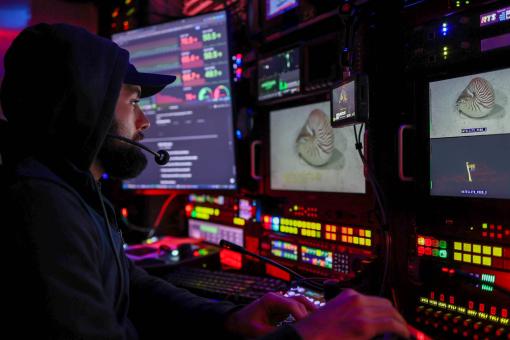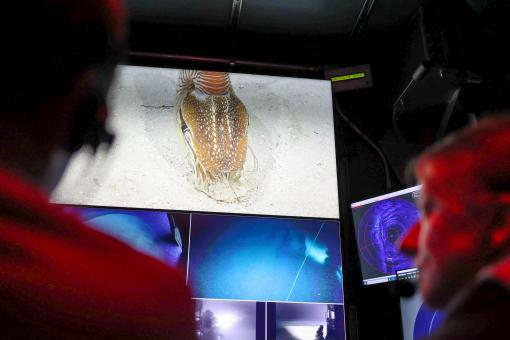Seeing Nautilus belauensis from E/V Nautilus

Blog by Communications Lead Marley Parker
Footage of a sandy seafloor fills the large monitors in the control van aboard E/V Nautilus. Three hours ago, we deployed ROVs Hercules and Atalanta for the final science dive of the year. Working with our team onboard from the Scripps Institution of Oceanography and our colleagues onshore at the Coral Reef Research Foundation in Koror, Palau, we are currently surveying the geomorphology of German Channel. We are also collecting data on the diversity and density of deep-sea biology here.
So far, we’ve conducted two Norbit mapping surveys, and we’ve seen lots of sea cucumbers and a few six-gill sharks. But for the past 20 minutes, we’ve been staring at undulations in the sand and chatting about currents and tides.

Pilot Robert Waters is sitting in the Hercules seat. He casually remarks, “What’s that white thing floating up ahead?”
Cue the explosion of exclamations and shrieks of excitement from everyone in the van.
“It’s a nautilus!”
“A NAUTILUS!”
“Look at that!”
“It’s finally happened!!!”
“A nautilus on Nautilus! Dreams come true!”
Dreams come true indeed. After more than 1,000 ROV dives all around the world, we are filming the beautiful animal that shares our name.
While our ship, E/V Nautilus, has been exploring the ocean for 15 years, the iconic spiral-shaped marine mollusk called nautilus has been around for much longer.
Found across the Indo-Pacific Ocean, the family Nautilidae originated during the Triassic period, around 200 million years ago. But the genus Nautilus came along more recently, around 38 million years ago. However, the evolution of nautilus can be traced back nearly 500 million years through the shell remains of its extinct ancestral species.
Because their structure has changed so little during that immense timespan, nautiloids are often referred to as “living fossils”.
We’ve never spotted one with Hercules because the preferred depth range of these animals is shallower than most of our ROV dives and the ship has spent limited time in its home range. Here in Palau, the nautilus range extends from less than 90 meters to over 500 meters. When we send Hercules and Atalanta to the seafloor, they are often operating at depths between 1,000 and 4,000 meters.
But today, during our exploration of the German Channel, ROV Hercules glides through the water at a depth of 380 meters – smack dab in the middle of nautilus territory.
As the nautilus fills every monitor in the Control Van, we gaze at its distinctive shape, its vibrant colors, and the intricate markings on its shell and tentacles.
“It’s so beautiful,” I say, feeling a childlike sense of awe. “Let’s just stay here forever.”
Pat Colin, Director of the Coral Reef Research Foundation, is connected to our audio conversation from shore. Though he is quick to say he is not a “nautilus expert”, Pat provides some valuable context and general information about the animal that we’re so excited to see.
“Palau has been a hotbed for nautilus research for the past 50 years,” he says. “This is actually a species that is endemic to Palau – we call it the Palau nautilus, or Nautilus belauensis.”
This particular nautilus is a speed demon, propelling itself through the water with surprising haste and agility. Robert skillfully maneuvers Hercules in a backwards motion to keep the small, nimble animal within the frame of our main camera.
But flying Hercules is not like driving a car – you can’t just slam it into reverse.
“We have limited visibility behind Hercules because all the good cameras are up front,” Dan Cormany says. “We have three cameras facing aft, but they are not optimized for traveling backwards.”
Flying Hercules in reverse includes some hazards and challenges: the risk of collision is higher and visibility is much more limited.
Fortunately, Robert is one of the most experienced deep-sea pilots in the world. While we continue to celebrate this momentous sighting, he focuses on the task at hand, keeping the speedy nautilus in our sights.

It takes more than one person to operate a two-body ROV system though. While Robert deftly maneuvers Hercules, Dan Cormany repositions Atalanta. Lead Navigator Lynette Davis has already called the bridge to stop the ship. In the video engineer seat, Jacob Ottaviani maintains a strategic level of zoom – close enough to capture quality video but wide enough to allow Robert and Dan to keep their bearings.
After 10 minutes of following the nautilus in a circuitous path, Robert says, “alright, that’s all we got.”
Jacob pulls the camera wide, and Robert and Dan reorient the vehicles to continue on with the dive.
We leave the nautilus in our wake, but comments continue to pour in from Nautilus Live viewers. Many people share our excitement and ask dozens of excellent questions.
Can the nautilus stop swimming?
How long do these animals live?
Do people eat nautilus? Is it protected?
Are there any local cultural stories about nautili?
These prompts guide Pat’s input from shore, and the whole team learns a great deal about these fascinating creatures. Contrary to the behavior we just saw, the nautilus can stop moving, and they may live for up to a couple of decades. According to Pat, people do not eat nautilus, at least not in Palau.
While the Palauan nautilus population is healthy and stable, in some other regions they have been fished to near extinction for their shells. All nautilus species are protected by the Convention on the International Trade in Endangered Species.
“They are solitary creatures, but there are a lot of them at depth,” Pat says. “I wouldn’t be surprised if we saw a few more.”
Eventually, our conversation returns to an earlier topic: waves and tides. As Hercules continues to glide above the sandy seafloor, Kaley Mudd and Ray Young finish explaining how internal waves and tides affect biological productivity. Kaley and Ray are both PhD students at the Scripps Institution of Oceanography and we are keen to learn from their physical oceanography expertise.
Ray is asking a question about bathymetry, when Lila, our science manager, interrupts.
“What’s that on the bottom right?” she asks.
“Is it another one?”
“I don’t know – I don’t want to say anything,” Lila says hesitantly. “It looks like another one.”
Robert turns Hercules to the right and Jacob starts to zoom in. We can clearly see the distinctive (and now familiar) shape of a nautilus.
“Yep! Here we go again!”
In stark contrast to our first sighting, this nautilus is resting on the sand, swaying slightly in the current.
“All you have to do to see a nautilus is start talking about internal waves,” Kaley says, and we all laugh.
When this footage is reviewed by Bruce Carlson, a local nautilus expert, he informs us this second animal is a juvenile.
“It’s very interesting since they are infrequently captured in traps,” Bruce says. “You can tell it’s a juvenile because the striping pattern extends all the way to the lip of the shell, and there is a yellowish coating on the shell.”
Since this nautilus is holding perfectly still, Dan and Robert can relax, and Jacob can zoom the camera all the way in. Pat tells us more about Nautilus belauensis versus Nautilus pompilius, referring to research Bruce Saunders (another nautilus expert) conducted in the 1970s to find morphological differences between the two.
As we listen to Pat, other members of the team start filtering into the control van – the morning watch is done. Alice Chou is taking my place in the SCF seat, and Jake Bonney and Rhye Rolls-DeWolfe are ready to take over the ROV controls.
With the cameras still fixed on the stationary nautilus, Dan and Robert high-five each other. “Epic time for a watch change,” Dan says. “What a way to end the season.”

Dive #H2085 included a total of four nautilus sightings. Watch the video highlight here.

Mapping and Water Column Exploration Offshore Palau
Following two E/V Nautilus expeditions focused on exploring the deep sea in the Palau National Marine Sanctuary, this 17-day expedition will center on surveying the oceanography and current flow around the Palauan Islands, and how this affects both near and offshore ecosystems, including those within the Palau National Marine Sanctuary.



